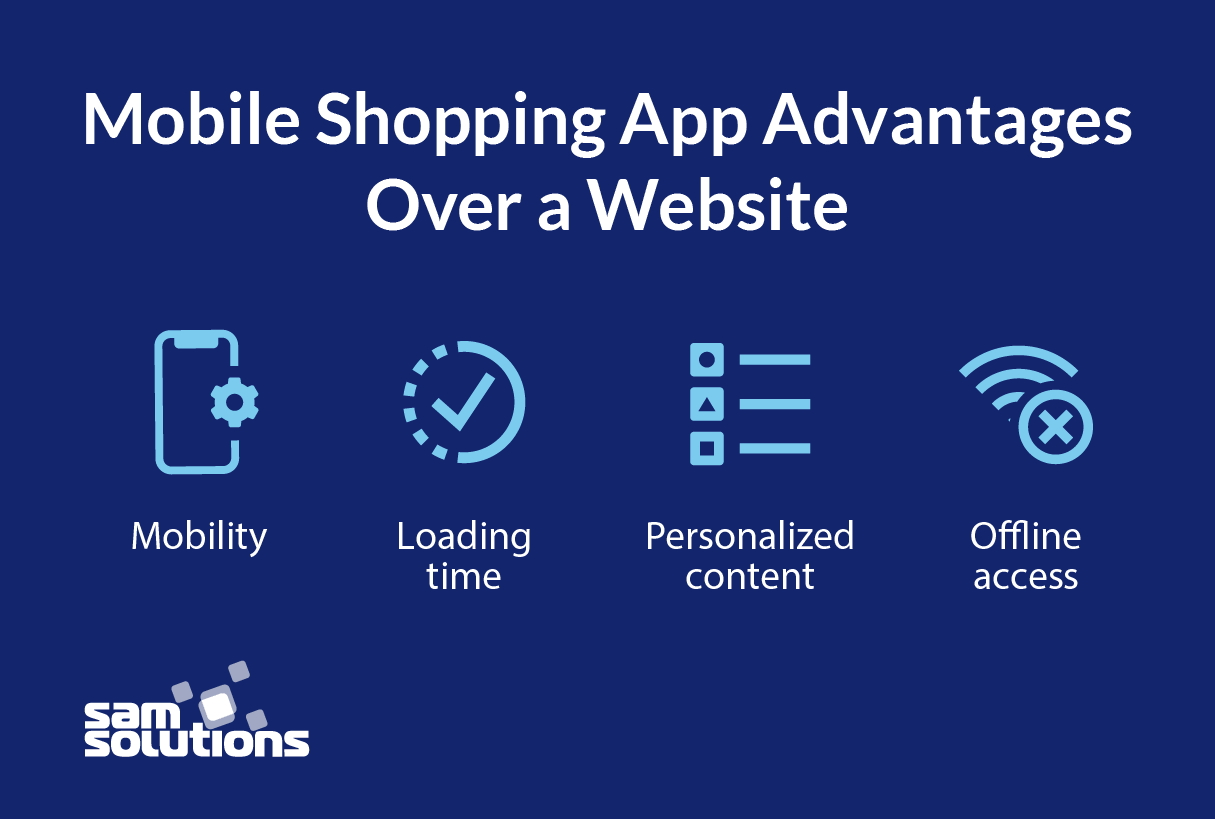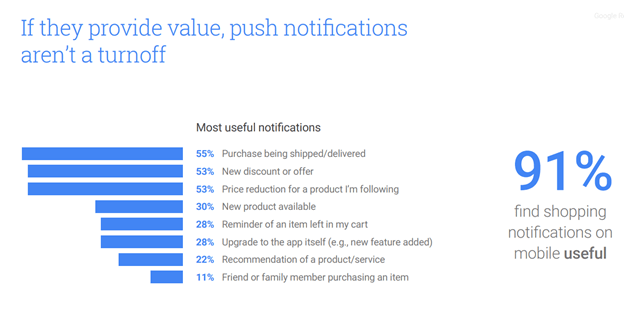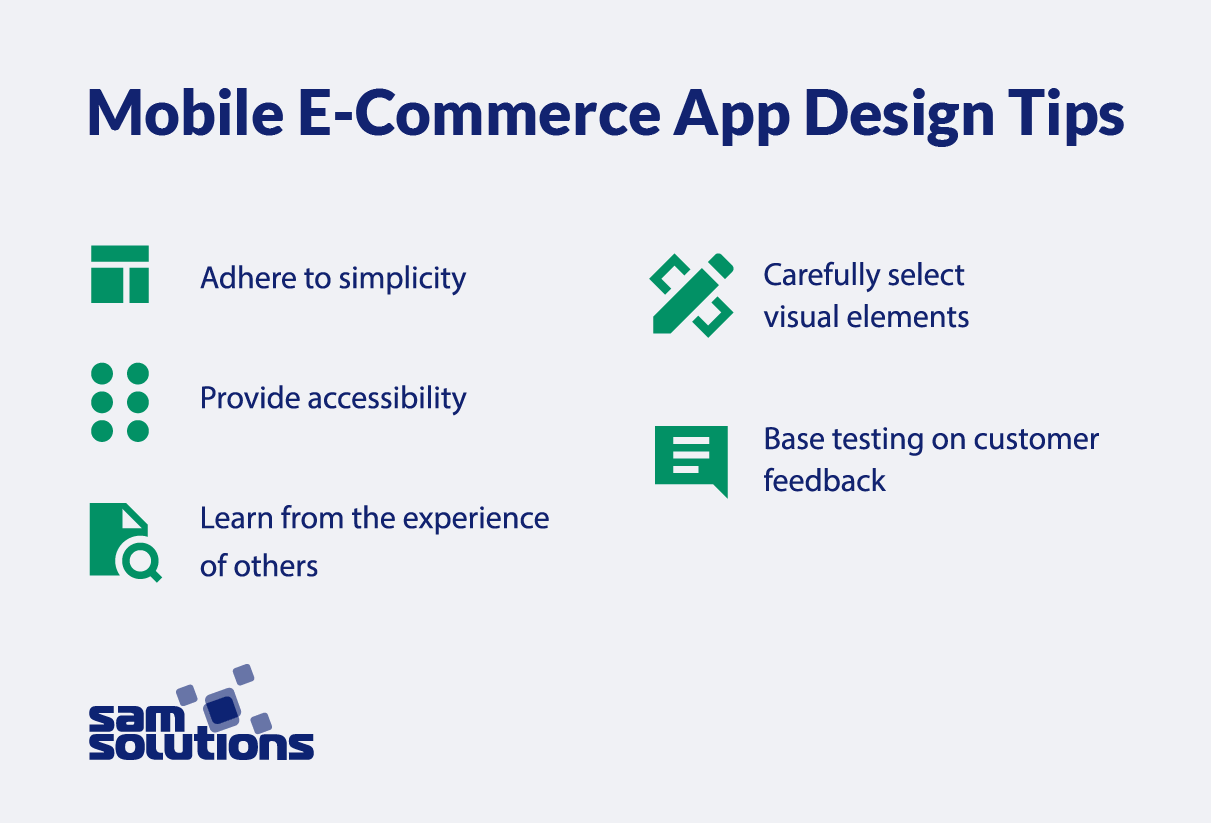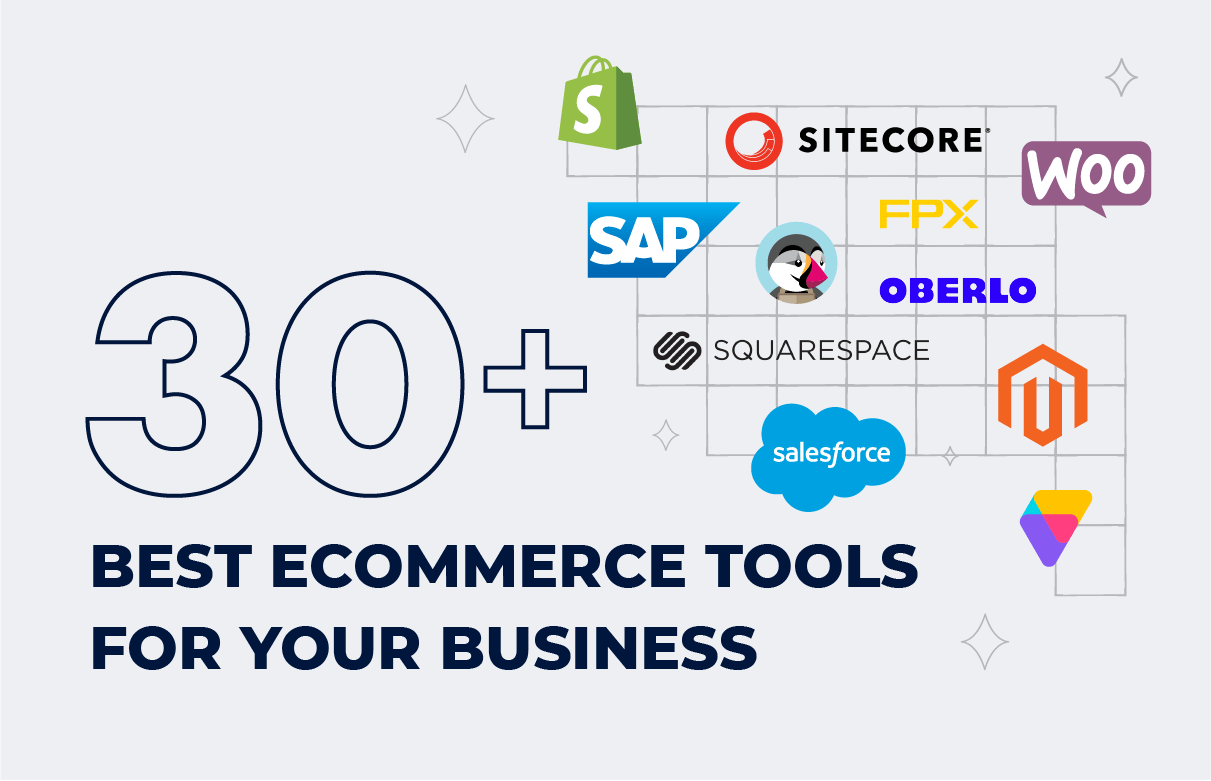Within the context of increasing online sales, the eCommerce industry is witnessing the most significant growth of mobile solutions development dictated by the need to satisfy customer desires. Consumers require the freedom to purchase goods and services anytime and from anywhere, even on the go. Hence, more online shoppers prefer mobile eCommerce applications to websites, as they offer advanced speed, convenience and adaptability. How can retail companies that are doing business in the digital space benefit from mobile applications? Let’s see.
SaM Solutions offers a wide range of platform-based and from-scratch ecommerce development services that help you reach your digital sales objectives.
From eCommerce to mCommerce
With the launch of the App Store and Android Market (presently Google Play) in 2008, the mobile app development market has become a prosperous niche, resulting in the rapid increase of available applications.
As of the first quarter of 2020, the number of apps available for download on the leading mobile app distribution platforms exceeds 4.4 million units.
The demand for qualitative mobile app design and development is especially high in the eCommerce industry, which is proved by the emergence of its subset — mobile commerce or mCommerce.
This is super convenient when consumers can place orders and pay for them via handheld devices (smartphones, tablets), having virtually thousands of goods from dozens of stores right in the pocket, so the trend is gaining popularity.
The worldwide sales through mobile devices are estimated at $2.3 trillion in 2019 and predicted to hit $3.5 trillion in 2021, which will compile 72.9% of total eCommerce.

Source: Statista
According to Shopify, mobile phones and tablets were the preferred shopping channels on Black Friday and Cyber Monday 2019, accounting for 69% of total sales.
What are the reasons that mobile eCommerce app development is one of the most popular directions in the IT world today? The thing is that software solutions for mobile devices open up new channels for retailers to connect with their customers, reaching wider audiences. There are some other benefits for online shops coming with mobile technology as well.
Benefits of Developing Mobile Apps for eCommerce Stores
Mobile commerce is growing exponentially these days. If you want to build a successful trading enterprise and focus on attracting customers and increasing sales, the importance of having mobile eCommerce solutions should be obvious. Actually, there are numerous reasons why you should have a mobile solution for your webshop. We’ve picked out the four most important benefits of eCommerce apps for your business.
1. Loyal Customers
Although a mobile app is a copy of the existing website, it is highly optimized, personalized and well-designed, which significantly improves customer experience and facilitates the acquisition and retention of new clients. They find themselves in a convenient online store where they can choose goods and purchase them without the hustle and bustle.

Here are some important advantages of a mobile shopping app over a responsive website:
- Mobility. Consumers get more freedom while using applications anytime and from any place.
- Loading time. Application pages load faster, therefore, they reel in more clients. Managers should realize that in the retail business, seconds count. Most visitors will leave the site if it needs more than three seconds to load and they will likely turn to competitors.
- Personalized content. Shopping preferences and previous orders can be saved in the app, serving as the basis for personalized offerings.
- Offline access. The best eCommerce applications can provide users with the basic functionality (to compare products, to check prices) even offline using a full-power performance of a smart device.
Thus, eCommerce apps are able to create a solid loyal audience for your company.
2. Brand Recognition
Mobile apps support strong connections between brands and customers. For example, users willingly share links to their favorite sites, ask for feedback and describe their customer experience in social networks. You can integrate popular social media platforms into your application to let customers discuss your products and services.
These are powerful tools for building your brand’s reputation, advertising your service and drawing the attention of potential clients.
Moreover, mobile users have amazing opportunities to get push notifications with special offerings, discounts and giveaways. This means that they can save money, so from a psychological perspective, they are likely to interact with such shops on a regular basis.
3. Better Efficiency and Increased Revenues
As a rule, mobile applications are more flexible and user-friendly. Although their implementation is quite expensive, they are likely to quickly pay off and increase sales. The correlation is simple: a good app with the right concept and functionality brings more clients; more clients result in more orders, consequently, your earnings are increasing.
In addition, push notifications are a cheap and effective channel for increasing sales and maintaining the brand. Via push notifications, you can instantly deliver essential information to your customers and inspire them to make immediate orders.

Source: Google
4. Detailed Analytics
Data is easy to gather and track in the application. Mobile functionality allows you to monitor users’ interaction and gives you useful information about them, such as responsiveness to particular content and features, feedback, session length, audience composition. This may help deliver improvements and updates, create personalized content, develop an advanced marketing strategy and efficient promotional campaigns and. Do make use of mobile analytics.
5. Contactless Payments
Individual smartphones can now replace cash and credit cards due to the invention of mobile contactless payments technology. Payment apps provide ease, speed and security. At the checkout, you don’t need to get a wallet from your bag to take out coins, banknotes, or credit cards. Put the phone to the payment terminal and that’s it!
It has become especially urgent during the COVID-19 pandemic, when people have to avoid touching things and try to reduce the time spent in shops.
How to Develop an eCommerce Mobile App
Custom development of a native mobile solution for an eCommerce business is quite a challenge. You should follow some definite steps and pay attention to lots of details in order to get the process right. Here is the guide with the main building blocks needed to plan and create your mobile solution for online trading.
Strategy
First of all, you need a strategy. Define your goals, the market you want to cover and the target audience you need to reach. This will help you imagine your future app, determine the functions the app should perform and describe your ideas to the development team.
Design
How to create a mobile app that will generate profits and make your users happy? You need a thought-out design that is both pleasing to the eye and easy to use.
“Design is not just what it looks like and feels like. Design is how it works.”
Steve Jobs
Most people rely on their first impression when evaluating something. It takes a person around 50 milliseconds to form an opinion about an object and decide whether he or she likes it or not. So, the appealing layout design of a mobile app ensures a positive user experience, which significantly increases customer loyalty and speeds up the payback.
Here are some tips on creating an appealing app design.

1. Adhere to Simplicity
Users prefer interaction with simple and logical navigation elements, as they don’t want to waste time on solving puzzles to perform an operation. Any complication is the wrong approach to design.
Quite often, mobile app designers try to add as many features as possible, believing that this would bring the app up to the top positions. This is particularly an issue for teams where everyone has multiple ideas and the team considers all of them essential. In reality, the more concise the app, the better.
The application must do exactly what the user needs and nothing more. It can be described by the term “flat design,” which means minimalism and usage of simple elements.
2. Provide Accessibility
Good design is accessible design. Today, it is not enough to focus on the target audience only; you need to make sure the product is available to all users.
Design accessibility means the absence of negative emotions when interacting with the application. If certain categories of people can’t use your product, it is better to start over.
One of the main mobile app design tips is to ensure that the application is available for people with limited abilities. Today, millions of users are vision or hearing impaired, and not taking care of their needs could be a fatal mistake for your business.
Microsoft and other leading IT service providers offer a range of tools and technologies to assist people with disabilities in removing digital barriers and providing equal opportunities. More and more developing companies work in accordance with the WAI (Web Accessibility Initiative) concept.
Another point is compatibility with all possible devices. In order to cover most of the market, your solution should equally perform on Android, iOS, or other platforms, as well as be optimized for different screen sizes and resolutions.
3. Learn from the Experience of Others
The majority of successful applications have similar features in their design, be it the layout, the icons or gesture navigation. So, when it comes to creating a new custom app, there is no need to reinvent the wheel. You should analyze the best practices of your competitors and create the product on their basis. This doesn’t mean plagiarism and the absence of creativity. This means that you should capitalize on the examples of positive experience.
Users prefer intuitive interaction and expect to see familiar features in a new solution. The designer should understand user needs and be extremely careful with innovative ideas while creating the interface.
Certainly, innovative technologies and market trends can facilitate the appearance of new features. If implemented step by step, they can help you reach new customers and establish a greater presence in the market.
4. Carefully Select Visual Elements
The most useful UX/UI design tips concern visual elements because they facilitate user engagement more than anything else. Follow the tips below to create an appealing visual interface:
- Choose appropriate fonts that fit the app’s idea and, at the same time, are legible. Don’t become addicted to fancy fonts: they may seem beautiful in isolation but, used on an app, they may completely ruin the experience.
- Don’t neglect colors, they may either create a positive impression from interacting with an app or make the experience disappointing.
- Be consistent to provide a positive customer experience. Design elements should guide users in their actions and not mislead them — so you can not dramatically change the rules of the interaction. All pages of your app should support the same style and idea.
5. Base Testing on Customer Feedback
Even the smallest error can make users delete the application. If the design is not clear or the font is not readable, an application is unlikely to become popular. Hence, a solution must be constantly tested. The best option is to base your testing phase on end-user feedback because only users know what’s best for them.
Development
This is a complex process of turning your ideas into reality and creating source code. Due to modern trends, mobile devices should be compatible with Android, iOS and Windows, with no limits. In this regard, think about developing cross-platform apps.
Effective communication is mostly reached by intuitive UI. You can use different design libraries to choose the most suitable icons and graphical features. Cocoa Controls is a popular open-source service for iOS components. Android Arsenal provides a collection of UI designs for Android developers.
After designing the UI, it is necessary to choose a framework to create an eCommerce mobile application. It should allow you to access data from any web server. Here are some popular mobile eCommerce platforms:
- WooCommerce is the leading open-source eCommerce platform that powers more than 28% of all online stores. It is the most customizable tool for building your online business.
- Magento is one of the most popular open-source platforms. It is written in PHP, fully scalable and available to all types of businesses.
- PrestaShop is another strong open-source framework. It has comprehensive product features for small, medium and large eCommerce stores.
These frameworks are suitable for small and medium stores. Actually, the list is endless, and it’s up to you to decide which one to choose.
One more step of app creation is the integration of a payment gateway, as it is important to provide a safe and secure payment system for your customers. Without a gateway, banking information will be at risk. The most popular internet payment systems are PayPal, Google Wallet and Apple Pay.
Marketing
Once the mobile app for your eCommerce business is ready, you should think about its promotion. There should be a good strategy for how it will be distributed. You can use social networks, newsletters, email blasts, adverts and other tools for wide app adoption. You may also work with competent marketing specialists who will bring your app to the forefront.
Maintenance
As eCommerce mobile apps are used for online purchases, security issues are crucial during the development process and afterward. Make sure that your developer provides several levels of security and complete project maintenance and support after the launch. Unless clients trust your system, they will not download your application.
How Much Does It Cost to Build a Mobile eCommerce App?
The cost of an eCommerce project development consists of several components. To evaluate the approximate cost of your future solution, you should consider them all.
Development Costs
- Salary for developers, project managers, designers, QA engineers
- Infrastructure
- Web services
- Social media integration
Additional Costs
- Support
- Marketing
- Advertising
- Updates
The cost also depends on the development platform:
- iOS apps can be built quicker, therefore they are cheaper as compared to Android projects
- Android apps are more expensive and take more time to build
The complexity of the project should be taken into account as well. Roughly speaking, development costs may range from $1,000 for a simple iOS app to $150,000 and more for complex apps.
Make your services or business accessible at your clients’ fingertips with mobile app development from SaM Solutions.
Find a Reliable Business Partner
Digital commerce is a large ecosystem that involves customers, vendors, marketing activities and technologies. Today, building an eCommerce mobile app is obviously an essential step for sales companies.
Having an eCommerce website is good when the project goes live. It tests how the business idea works and provides information about the market. But a website is not enough for further development and conquering a wide audience. This is the main argument for online retailers to create corresponding mobile eCommerce apps. They help attract more clients, increase revenues and grab a significant market share.
SaM Solutions’ team of experts has the capacity to create mobile apps that will help your business gain more traction and captivate the attention of your customers. We are willing to provide you with the following services:
- Business needs and requirements analysis
- The design of the mobile application
- Interface usability improvement
- Cross-platform development
- Legacy solutions optimization
- Mobile testing
We propose a great opportunity for the successful execution of your digital commerce strategies. The contact form is the quickest way to reach us if you want to learn more about our mobile and eCommerce expertise and get answers to your questions.



























 5 Reasons Why Your Business Needs a Mobile eCommerce Application
5 Reasons Why Your Business Needs a Mobile eCommerce Application Using Salesforce to Improve Your Sales Pipeline: Five Tips
Using Salesforce to Improve Your Sales Pipeline: Five Tips Cross-Platform Mobile Development: Five Best Frameworks
Cross-Platform Mobile Development: Five Best Frameworks How to Develop Custom Accounting Software
How to Develop Custom Accounting Software 10 Best Web Development Frameworks in 2024
10 Best Web Development Frameworks in 2024







![What Is Ecommerce Customer Service? [Including 8 Best Practices]](https://www.sam-solutions.com/blog/wp-content/uploads/Customer-Service-in-eCommerce.png)



